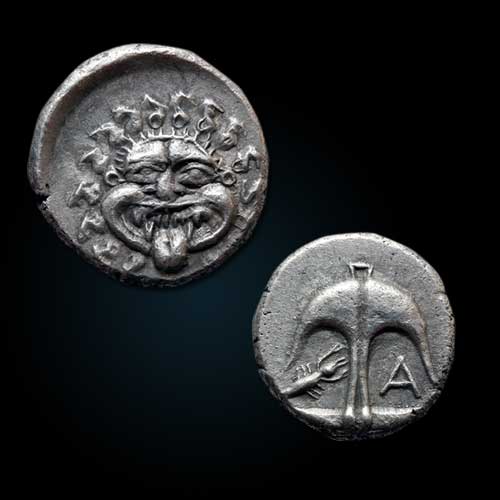Apollonia Pontika Drachm
2021-12-22 Wed
Apollonia Pontika was a colony of Miletos. The main types for the city's coinage were a gorgoneion - presumably as an apotropaic device to protect Apollonia from evil - and an anchor, emblematic of its importance as a port city. The Gorgoneion is usually shown as the obverse as I have it here, but in reality, the upside-down anchor is considered the obverse.The 5th and 4th century BC coinage of Apollonia Pontika reflects that city’s origins: commercial wealth and maritime power. The gorgon was a popular apotropaic device, seen as warding off evil; thus a number of ancient Greek cities adopted it as a coin design. The anchor and the crayfish attest to the city’s reliance on maritime commerce for its economy, and the anchor depicted on these coins is actually one of the first anchors of modern design rendered in Greek art.
Image Courtesy: numis.org
Latest News
-
Gold Pagoda of Vijaynagar Empire King Deva Raya I
2024-04-10 WedKing Deva Raya I of the Vijayanagara Empire was a patron of Kannada literature and architecture. He ...
-
Silver Denarius of Septimus Severus
2024-04-05 FriLucius Septimius Severus served as the Roman emperor from 193 to 211 AD. Severus sat on the throne o...
-
Extremely rare 'Malaharamari' type Gold Gadyana of King Guhalladeva-III Sold for INR 611000
2024-04-03 WedTribhuvanamalla, also known as Guhalladeva III, was the ruler of the Kadamba dynasty. His reign coin...
-
90 Years of RBI
2024-04-02 TueOn 1st April, PM #Modi unveiled a special commemorative coin marking 90 Years since the foundation o...
-
Silver Denarius of Julia Mamaea
2024-04-02 TueJulia Avita Mamaea, a Christian Syrian noblewoman, was the mother of Roman Emperor Alexander Severus...

